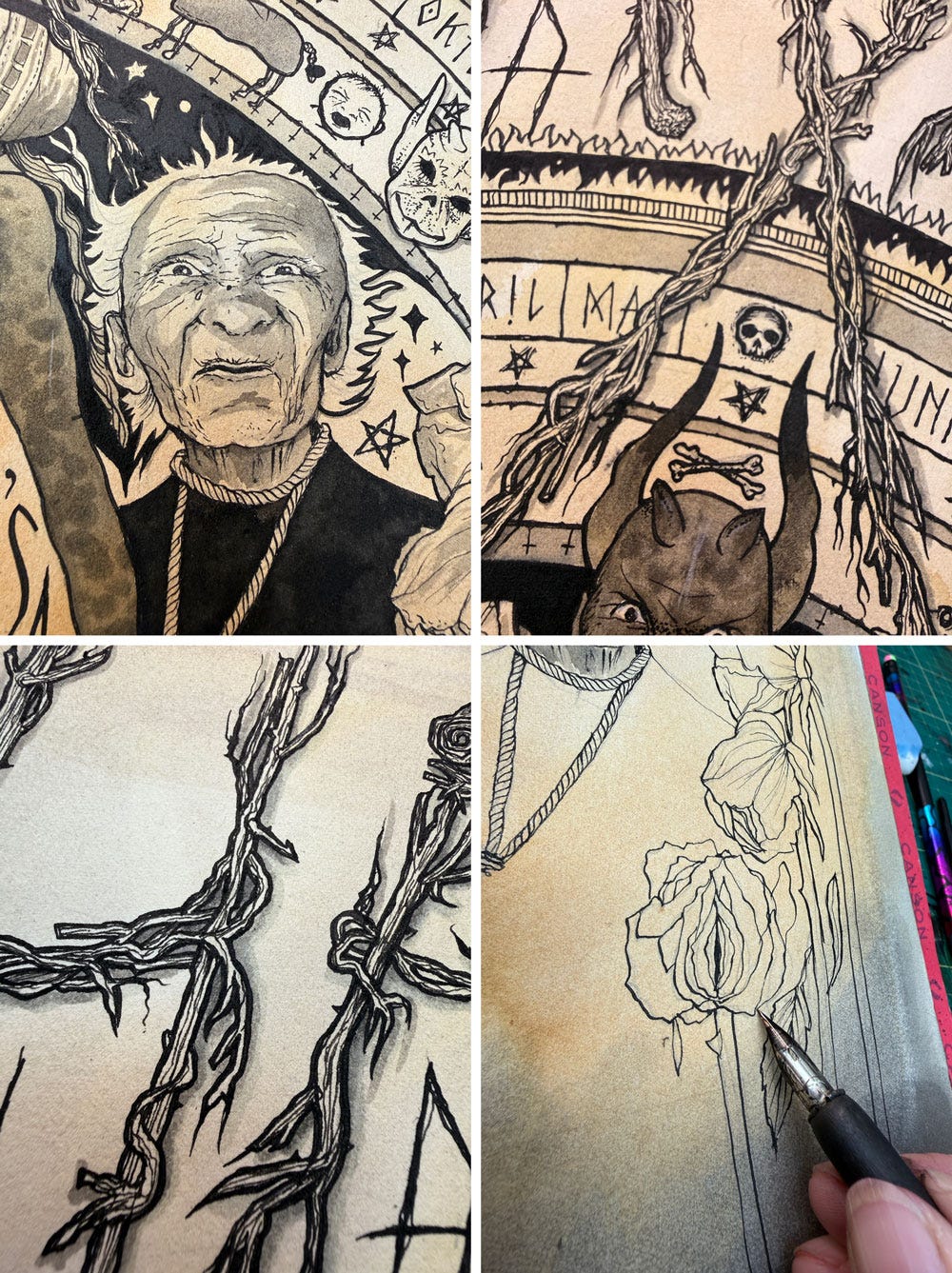Friday 3rd is not 13th, but it’s a good enough day in October for my first post in ages. It’s been a busy and very fast summer, but more on that, and the failing-to-Substack guilt that’s been gnawing on my right hand the whole time, in a later post.
For now, here’s my new poster for the 1922 film ‘Häxan’, written and directed by Swedish filmmaker Benjamin Christensen — who also stars as Satan in the film.
Technically deeply impressive for its time, it’s a documentary-style exploration of how the characteristics and behaviours that led to women accused of being ‘witches’ in the past were potentially behavioural, hormonal, neurological or mental health issues, including now widely understood conditions such as insomnia (“she roams the night!!”) and depression (“look how the devil possesses her mood!”) It was revolutionary thinking at the time. Not only was it the most expensive Scandinavian silent film ever made to date, costing nearly two million Swedish kronor, it was eventually, and predictably, censored for what was at that time considered graphic depictions of torture, nudity, and sexual perversion, and anti-clericalism.

The film however points its sulphuric lamplight in the direction of their fellow women. Devoid of scientific or rational explanations for whatever awful thing they’re experiencing, mothers, daughters, friends and colleagues accuse the more vulnerable women in their community of ‘witchcraft’. According to the rules, to accuse a witch is to recognise one, and therefore to be one, and to prove you aren’t one — well. We are all surely familiar with the options available there; to quote the deliciously political warning of the folkloric Radiohead song Burn The Witch, “if you float, you burn”.
Witches are not a new subject for me. I took a clammy dive into a modern reimagining of the Pendle Witches for my 2009 exhibition ‘They All Came Back’, asking precisely that question: if the Pendle Witches were alive today, how would that look? How would they do their accusing? How would they muster the deadly hysteria that resulted in 10 executions? Mother accused daughter; daughter accused mother, man accused dog. I got my friend, author Dr. Ed Garland, to write the voices of each Witch, and I made pictures, and dolls, to accompany those voices.
This piece proposed the witches’ most obvious route to channeling hate, accusation and bile — Facebook. I set the witches up, and got them talking. They’re all me, and I’ve sprinkled in “direct quotes” from the records of the time, but boy that conversation could have rolled on. It was delicious.
(and by the way. I didn’t know how to delete the profiles of the ‘witches’ I’d created for the purposes of this piece. So I left them there. And — I’m not making this up — when I finally logged back in years later, there’d been, shall we say, ‘activity’. Having lost the password long ago, I can’t get back in to check whether Alizon, Anne and Kath carried on baiting each other. I hope they did. I hope it’s a total maelstrom of utter spite and shitposting in there).
Created for illustration collective Hire an Illustrator’s new project ‘The Video Shop: A Blockbuster Experience’ curated by Darren Di Lieto, this was an invitation to reimagine one of 13 classic movie posters. I chose this film from a list of terribly appealing, Halloweeny options — Nosferatu, Little Shop of Horrors, Night of the Living Dead — but I went for this one because of its important role in introducing some prematurely modern ideas about women’s health. It felt uncomfortably relevant, and I’ve learned the hard way that discomfort is historically what produces my best work (a literal example, one of many, is to be found here). Naturally, my poster delights in the panto-esque Satan and his wobbly tongue, but I’ve flanked him with the ‘hysterical’ nun (if you don’t know, look up exactly where that word comes from!) and Maria The Weaver, the poor elderly lady who is tricked by a man of the cloth into confessing to witchcraft.
I remain doubtful about whether we have genuinely moved beyond baying mobs pointing fingers at other humans and shouting ‘witch’; all the way back in 2009, I was asking what is social media if not an omnipresent, all-welcome opportunity to do just that, should we choose it, either through fear or rage or panic (each being borne from the other)? But that’s a whole other blog. I am fully aware of the globally harrowing context in which I’m writing this, and it’s another reason why I grasped at illustrating a film which wasn’t just ‘fun horror’ and entertainment — though god (or the devil) knows we need escapism, even if horror-shaped, in a time of genuine, creeping dark.
Thanks to Darren for the opportunity to take part in such a ‘Sarah-perfect’ project.
You can, if you would like, buy a print of mine or any one of the other 12 pieces in this show:

No comments:
Post a Comment